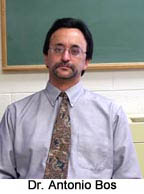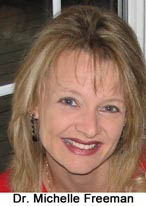Two Tusculum professors, Dr. Antonio Bos and Dr. Michelle Freeman, have work featured in national publications.
Dr. Bos’ research involving the effects of a low-fat diet in prevention of breast and ovarian cancer is included in this month’s Journal of the American Dietetic Association.
Dr. Freeman’s article documents her experiences with “Teaching Circles” at Tusculum and their effects on professors’ classroom instruction.
Bos’ research
Research by Bos indicating that using a low-fat diet could be more cost effective in preventing breast cancer and ovarian cancer compared to what health insurance companies would otherwise pay to treat the diseases, is published in the January 2011 issue of the “Journal of the American Dietetic Association.”
 The research paper, titled “Cost-effectiveness Analysis of a Low-fat Diet in the Prevention of Breast and Ovarian Cancer” is authored by Dr. Bos, professor of business administration at Tusculum College.
The research paper, titled “Cost-effectiveness Analysis of a Low-fat Diet in the Prevention of Breast and Ovarian Cancer” is authored by Dr. Bos, professor of business administration at Tusculum College.
“This is my most important scholarly work of date,” said Bos. “It has taken a substantial time commitment over the last few years. Needless to say, I am very pleased to have it published in such a prestigious journal, and I am appreciative of the support I received from Tusculum College during this project.”
Bos was the lead author of the research paper, along with co-authors Dr. Barbara Howard of Georgetown University; Dr. Shirley Beresford of the University of Washington; Dr. Nicole Urban of the Fred Hutchinson Cancer Research Center; Dr. Lesley Tinker, also from the Fred Hutchinson Cancer Research Center; Dr. Hugh Waters of the Bloomberg School of Public Health, Johns Hopkins University, Dr. Angelo Bós, from the Pontifícia Universidade Católica do Rio Grande do Sul, and R. Rowan Chlebowski, from the Harbor/University of California at Los Angeles Medical Center.
The researchers assessed how cost effective the Women’s Health Initiative Randomized Controlled Dietary Modification Trial (WHI-DM) would be if implemented as a public health intervention and under the sponsorship of private health insurers and Medicare.
According to the paper, breast and ovarian cancers were the health outcomes of interest. Two groups of WHI-DM participants formed the target population for this analysis: (1) participants with more than 36.8 percent of energy from fat at baseline and (2) participants at high risk for breast cancer with 32 percent or more of energy from fat at baseline.
The Journal of the American Dietetic Association is the premier source for the practice and science of food, nutrition and dietetics. The monthly, peer-reviewed journal presents original articles prepared by scholars and practitioners and is the most widely read professional publication in the field. The Journal has been ranked 16th in Impact Factor in the Nutrition and Dietetics category of the Journal Citation Reports 2010, published by Thomson Reuters, with an impact factor of 3.128. The impact factor is a measure of the frequency with which the “average article” has been cited in a particular period.
Freeman’s article
Dr. Freeman, associate professor of business administration, was recently notified that she will be published in the February edition of “The Teaching Professor.”
 The article, “Teaching Circles: A Low-Cost, High-Benefit Way to Engage Faculty,” will be the second article that Freeman has had published in the journal.
The article, “Teaching Circles: A Low-Cost, High-Benefit Way to Engage Faculty,” will be the second article that Freeman has had published in the journal.
The article details Freeman’s work over the past three years directing The Teaching and Learning Initiative at Tusculum College. The program has become more commonly known as Teaching Circles.
Freeman, who directs the program, works with four to six faculty members at the beginning of each academic year to select topics and relevant reading materials for groups that will be available to all faculty to become a part of for the year.
“The goal of these circles is enjoyable scholarly exchange between peers,” wrote Freeman. “Sometimes the focus is on pedagogy; other times it is a topic simply for knowledge expansion.”
The costs of implementing such a program are minimal, according to Freeman, who reports that the main investments are associated with books and materials, as well as a closing banquet and one dinner per group.
According to Freeman, the initiative has generated a number of benefits, including providing in-house faculty development, serving as a community builder across disciplines and serving as a way to ease new faculty into the college community.
In addition, the program has assisted other college programs, including the college’s Quality Enhancement Plan, which is a campus wide effort to implement the skills of critical thinking with reflective judgment into a cross section of campus curriculum, as well was in other key areas of the college. The program also provides peer incentives among professors to continue to improve.
“As faculty members learn together, they are challenged to make changes in their classrooms. Faculty participation in these circles offers evidence of ongoing interest in scholarship,” said Freeman.
“The Teaching Professor” is a targeted professional publication that focuses on educational teaching methods.


